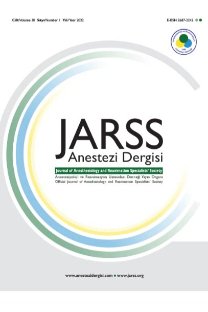Sedoanaljezide farklı dozda remifentanil uygulaması
Analjezikler, opioid, Cerrahi işlemler, operatif, Bilinçli sedasyon, Analjezi, Anestezi, lokal
Comparison of different doses of remifentanil in brief surgical procedures
Analgesics, Opioid, Surgical Procedures, Operative, Conscious Sedation, Analgesia, Anesthesia, Local,
___
- 1. Avramov MN, Smith I, White PF: Interactions between midazolam and remifentanil during monitored anesthesia care. Anesthesiology 1996; 85(6):1283-9.
- 2. Gold MI,Watkins WD, Sung YF, Yarmush J, Chung F, Nonita T, Maurer W, Clarke MY, Jamerson BD : Remifentanil versus Remifentanil/ midazolam for Ambulatory Surgery during Monitored Anesthesia Care Anesthesiology 1997; 87:51-7.
- 3. Monica M, Yoshimi I, White PF: Remifentanil Administration During Monitored Anesthesia Care: Are Intermittent Boluses an Effective Alternative to a Continuous Infusion? Anesth Analg 1999; 88:518.
- 4. Maranetes I, Kain ZN: Preoperative anxiety and intraoperative anesthetic requirements. Anesth Analg 1999;89:1346-51.
- 5. Lauwers M, Camu F, Breivik H, Hagelberg A, Rosen M, Sneyd R, Horn A, Noronha D, Shaika S: The safety and effectiveness of remifentanil as an adjunct sedative for regional anesthesia Anesth Analg 1999; 88:134-40.
- 6. SaRego MM, Inagaki Y, White PF: Remifentanil administration during monitored anesthesia care: Are intermittent boluses an effective alternative to a continuous infusion Anesth Analg 1999; 88: 518-22.
- 7. Chernik DA, Gillings D, Laine H, et al: Validity and reliability of the observer's assessment of alertness/sedation (OAA/S) scale: study with intravenous midazolam. J Clin Psychopharmacol 1990;10:244-51.
- 8. Litman RS: Conscious sedation with remifentanil during medical procedures. Journal of Pain and Symptom Management 2000;19: 6.
- 9. David PS, Wechsler RT, Feig SA. Migration of breast biopsy localization wire. American Journal of Radiology. 1988;150: 787.
- 10. Randel GI, Fragen RJ, Librojo ES, et al: Remifentanil blood concentration effect relationship at intubation and skin incision in surgical patients compared to alfentanil (Abstract). Anesthesiology 1994; 81:A375.
- 11. Amin HM, Sopchak AM, Esposito BF, et al: Naloxone-induced and spontaneous reversal of depressed ventilatory responses to hypoxia during and after continuous infusion of remifentanil and alfentanil. J Pharmacol Exp Ther 1995; 274:34-9.
- 12. Glass PSA, Hardman D. Kamiyama Y, et al: Preliminary pharmacokinetics and pharmacodynamics of an ultra-short acting opioid: remifentanil(GI87084B). Anesth Analg 1993; 77:1031-40.
- 13. Lydic R, Keifer JC, Baghdoyan HA, et al: Microdialysis of the pontine reticular formation reveals inhibition of acetylcholine release by morphine. Anesthesiology 1993; 79: 1003-12.
- 14. Splinter W, Noel LP, Roberts D, Rhine E, Bonn G, Clarke W. Antiemetic prophylaxis for strabismus surgery. Can J Ophthalmol 1994; 29: 224-6.
- 15. Sanjay SP, Caroline MS. Remifentanil. Drugs 1996: 52; 417-27
- ISSN: 1300-0578
- Yayın Aralığı: 4
- Başlangıç: 1993
- Yayıncı: Betül Kartal
Laparoskopik kolesistektomilerde TİVA ve VİMA'nın hemodinami ve derlenme özellikleri
Okutan Ebru ALAGÖZ, BELGİN AKAN, Murat TEKİN, Demet ALBAYRAK, Nermin GÖĞÜŞ
H. Ömer AYANOĞLU, Sezgin ULUKAYA, NÜZHET SEDEN KOCABAŞ, A. Zeki ÇÖKMEZ
Koroner revaskülarizasyon operasyonlarında sevofluran'ın böbrek fonksiyonlarına etkisi
Fahriye GÜLER, Tuncer KOÇAK, Füsun GÜZELMERİÇ, Halide OĞUŞ, Mustafa GÜLER, Meral SEVİNÇ, Çiğdem YAKUT
Anestezi indüksiyonu sırasında iki farklı dozda remifentanil infüzyonunun karşılaştırılması
Tezcan Gönül KELEŞ, E. Alp YENTÜR, Melek SAKARYA, Verda TOPRAK, Gülay OK, Taner TAŞYÜZ
Kanser ağrısı ve transdermal fentanil kullanımı
Emine ÖZYUVACI, Aysel ALTAN, Şule VATANSEVER, Abdulkadir İSKENDER
Sedoanaljezide farklı dozda remifentanil uygulaması
Hakkı ÜNLÜGENÇ, Mehmet ÖZALEVLİ, Tayfun GÜLER, Geylan IŞIK
Meyancı Güniz KÖKSAL, Elif AŞKIN, HÜSEYİN ÖZ
Öztin Cemile ÖĞÜN, ATEŞ DUMAN, Çetin ÇELİK, Esma Nur KIRGIZ, Selmin ÖKESLİ
Morbid obez hastalarda cisatrakuryumun nöromusküler iletime etkileri
ZİYA SALİHOĞLU, Şener DEMİROLUK, Yıldız KÖSE
Günübirlik anestezi sonrası kognitif yetmezlik sorgulaması
Seda Banu AKINCI, Halide CEYHAN, Zeynep COŞKUN, MELİH AKINCI, Saadet ÖZGEN
